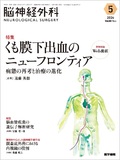Japanese
English
- 有料閲覧
- Abstract 文献概要
- 1ページ目 Look Inside
- 参考文献 Reference
Point
・脳動脈瘤の病態の本質は,血管分岐部の膨隆病変という特異的形態に起因する非生理的血流負荷により誘発される慢性炎症である.
・脳動脈瘤破裂過程では,病変部微小環境内で炎症により増悪する低酸素環境依存的な血管新生という構造的転換が生じる.
・脳動脈瘤破裂過程では,病変部での慢性炎症の微小環境が好中球を含む微小環境へ質的に転換する.
Intracranial aneurysms, a major cause of subarachnoid hemorrhage(SAH), pose a significant social burden due to their poor patient outcomes. Recent studies, including those using animal models, have shed light on a new disease concept: intracranial aneurysms as a chronic inflammatory disease. This process is triggered by abnormal hemodynamic forces and mediated by immune cells like macrophages and neutrophils. The initiation of intracranial aneurysms is a two-step process. First, high wall shear stress and mechanical stretch work together to promote macrophage infiltration into the arterial walls. This infiltration is facilitated by endothelial cells and fibroblasts, which are activated to produce chemoattractants. Once the lesions enlarge, low wall shear stress and turbulent flow take over, maintaining macrophage infiltration. As the disease progresses towards rupture, infiltration creates hypoxic conditions that exacerbate the situation. These conditions, in turn, induce the formation of neovessels at the weakest point of the aneurysm and promote specific inflammatory microenvironments rich in neutrophils. The excessive tissue destruction caused by neutrophil-mediated inflammation ultimately leads to lesion rupture. Therefore, intracranial aneurysm rupture requires not only structural changes but also qualitative alterations within the chronic inflammatory environment. This suggests that factors mediating chronic inflammation could be potential targets for predicting or preventing aneurysm rupture.

Copyright © 2024, Igaku-Shoin Ltd. All rights reserved.


